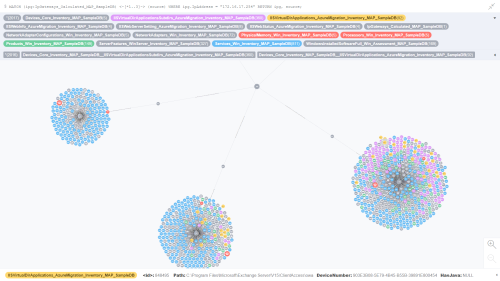[Updated November 6, 2016: Added Database/Web Services Farm Example #2]
In the previous article Crossing the EA Chasm: Automating Enterprise Architecture Modeling, I included a simple example of how a current state enterprise architecture model can be created and maintained automatically.
The same ModelMate enterprise architecture model has now been extended to include a total of 832,789 ArchiMate entities connected by 828,859 relationships (with several million property values) and was created automatically from scratch in about 15 minutes.
Database/Web Services Farm Example #1 (Single Subnet)
Below is a simple example of an automatically generated view depicting the database services and web services configured on the 38 servers connected to a particular IP subnet. There’s a total of 355 nodes in this accurate and up-to-date current state view. (Click the image to enlarge it)
Figure 1. Database/Web Services Farm Example #1 (Single Subnet)
Pretty cool. The green dots are database services (SQL Server instances to be exact – almost every possibly product edition can be found in this subnet: SQL Server Express, Developer, Enterprise, Datacenter, etc.) modeled as Infrastructure Services; the blue dots, servers (Windows physical and virtual servers) modeled as Infrastructure Nodes; and, the purple dots, web servers (IIS virtual directory applications to be exact) modeled as Infrastructure Functions.
The small orange dots represent the network adapter configurations of the network adapters configured into each server. The most central dot is the IP gateway (network router) for this subnet.
Database/Web Services Farm Example #2 (All Subnets/All Farms)
Figure 2. Database/Web Services Farm Example #2 (All Subnets/All Farms)
The red dots are IP subnets (32 in this ModelMate view) connecting 208 server Nodes that host either a SQL Server Instance (376 Infrastructure Service elements) and/or an IIS Virtual Directory Application (1597 Infrastructure Function elements). The small orange dots are network adapter configurations. (Click the image to enlarge it)
Microsoft Exchange Server Farm Example
Here’s one more example of an auto-generated view from the same ModelMate model: a Microsoft Exchange email, collaboration, and unified communications services farm. In this view, the blue dots are the Windows Services running on each of these 3 Windows Servers in this view (out of a total of 5 servers in the complete farm). The orange dot highlighted in gray near the top of the server on the right side, for example, is an IIS virtual directory application that is hosting an Outlook Web Access (OWA) web service. (Click the image to enlarge it)
Figure 3. Microsoft Exchange Server Farm Example
The larger red entity contains all of the descriptive information (metadata) for each server’s processor; the smaller red dot, the memory configuration for the server.
The Neo4j graph database from Neo Technologies was used as a key component of the ModelMate platform. A special ModelMate tool was created for automatically uploading any SQL Server database into a graph database (including all tables, columns, primary keys, primary key constraints, composite keys, foreign keys, foreign key relationships, implied entity relationships, NULL value processing, DateTime data type handling, etc.).
Have a great weekend,
Michael Herman (Toronto)
Parallelspace Corporation
*ArchiMate is a registered trademark of The Open Group.




Pingback: Crossing the EA Chasm: Automating Enterprise Architecture Modeling | hyperonomy.com - digital intelligence
Pingback: Graphitization of the Enterprise | hyperonomy.com - digital intelligence
Pingback: Michael Herman, Inventor: #Graphitization | hyperonomy.com - digital intelligence
Pingback: #Tokenization of …well… #Everything [WIP] | hyperonomy.com - digital intelligence